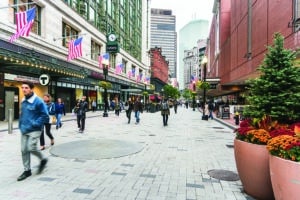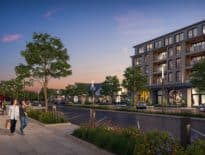
We are about to see whether Boston Mayor Michelle Wu can make some headway on bringing new life to storefronts emptied out by the pandemic.
Downtown Boston remains pockmarked with empty restaurants and shops, a reminder of the wrenching changes wrought by the pandemic.
Now we are about to see whether Boston Mayor Michelle Wu can make some headway on bringing new life to these long-dead storefronts.
The Wu administration is preparing to launch a multimillion-dollar campaign to fill dozens of empty restaurant and retail spaces in downtown Boston and in neighborhoods across the city as well.
It is the next step in a campaign that kicked off earlier this year, with officials putting on a series of events aimed at luring people back to the city, whether or not they are commuters.
The $9 million grant program, to be unveiled next month, is supposed to help budding entrepreneurs move into some of these empty restaurants, shops and storefronts, with a particular emphasis on providing opportunities to minority and women-owned businesses, said Segun Idowu, Boston’s economic development chief.
The money will be divided into $100,000 grants spread out over three years, with cash coming from federal relief funds.
Yet it won’t be easy, for City Hall’s downtown revitalization efforts face serious headwinds like the relentless rise of remote work. And the fact these challenges are not unique to Boston doesn’t necessarily make it any easier.
“I think every major city is having a conversation about the future of downtown,” Idowu said. “Boston is no different.”
“There are still quite a number of vacancies that we need and want to fill,” he said.
‘Quirky’ Shops for Empty Spaces
Idowu did not have a tally of the number of empty storefronts and restaurant spaces across city, but the vacancies were hard to miss on my recent walk through the Financial District and Downtown Crossing.
Some have been vacant for nearly two and a half years, like Hale and Hearty Soups in the Financial District, which still has the menu for March, 17, 2020 taped its now long-since shuttered front door. (Corned beef and cabbage and vegetarian split pea were the soup specials that day, if you were wondering.)
Boston’s economic development chief said he is hoping to get a greater array or variety of businesses to fill these spaces.
“We want more retail and restaurant businesses and more quirky businesses,” Idowu said, noting that a Black-owned skateboard shop has picked the area for its second location.
City officials also want to work with building owners and commercial landlords to lower rents for budding shops and restaurants.
Getting landlords to play ball, though, may prove to be a challenge, at least in some cases. Some building owners would invariably rather hold out for an aspirational rent. And in some cases, they may be willing to stick it out for years to get it, bad publicity be damned.
It has been a problem in Downtown Crossing in years past, and it’s hardly a phenomenon limited to Boston as many officials across suburban Massachusetts can attest.
A bigger challenge, though, will be getting enough people downtown to support these new ventures, in addition to the restaurants and shops that have managed to survive over the past two and half years.
‘Return to Office’ Over
You can forget all the post-Labor Day hoopla about the supposed return to the office.
Office occupancy numbers – as in the amount of office space filled with real, live human beings – barely budged after the holiday, according to the Kastle Group. While the firm doesn’t track Boston, New York’s office space is more than 60 percent empty, while D.C. is split roughly 60/40, as well.
Whether they like it or not, many companies appear to be settling into a hybrid schedule of three days in the office, two days remote.
And it’s not just the private sector that is embracing the virtual offices, but city and state governments as well.

Scott Van Voorhis
The Wu administration has been experimenting with a pilot program that allows city employees to work from home two days a week.
Given that the city employs more than 19,000 people, with a heavy concentration downtown, that’s a lot of missing coffee runs and lunches.
That said, the solution isn’t forcing workers back to the office, but rather to face up to the reality that the pre-pandemic world of daily commuting is gone and not coming back.
Idowu, the former president of the Black Economic Council of Massachusetts, certainly gets it. But with the future of the office market still uncertain, the road ahead promises to be long and challenging.
Scott Van Voorhis is Banker & Tradesman’s columnist; opinions expressed are his own. He may be reached at sbvanvoorhis@hotmail.com.




 |
| 
